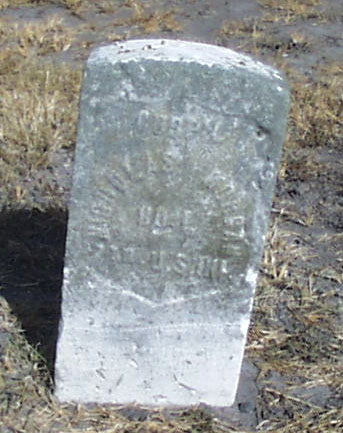Nicholas Morgan
Corp'l.
Nicholas Morgan
Co. 1
7th U.S. Inf.

Photo Credit: Rosa G. Gonzales
Biography
There is some confusion over this individual as the stone erected to honor his memory identifies him as “Nicholas Morgan, Corporal of Company I of the 7th U. S. Infantry�. This stone is one of those erected by E. J. Kilmer to honor soldiers who had served in the Federal forces of the United States. However, early lists of the Confederate dead reportedly gathered by the D.A.R. identify a “Col. Moore� as a member of the C.S.A. (Confederate States of America). The cemetery data book of Nueces County compiled by Dr. Charles Ward and Mr. Brooks Noel consequently lists among the burials of Old Bayview Cemetery a “Col. Moore, C.S.A.�. It may be that this is James N. Moore who was a Captain in the Infantry Company for Coast defense of the 3rd Regiment, Texas Volunteer Infantry. This group was under Col. P. N. Luckett and included many individuals from the Corpus Christi area. If this is so it may be that his middle name was “Nicholas� as his name is usually given as “James N. Morgan�. However, it is also possible that two individuals are actually buried in Old Bayview by the name of Morgan. The Confederate would most likely be James N. Morgan who is noted above. He may also be the James Morgan who is reported as marrying Rachel Byington in the presence of Judge Gilpin on January 1, 1862 (Nueces County Marriage Records, vol. C, page 26). However, by 1870 he is certainly not around as Rachel is again listing herself as Rachel Byington and a widow in the 1870 census. This James Morgan appears to be the 40 year old clerk from Kentucky who is listed as living with Elizabeth Wilson (25 year old from Illinois) in the 1860 census of Nueces County (p.287). Captain Morgan is referred to as “of the gallant Corpus Christi company� (Ranchero 25 December 1862, page 2 col. 3). In an 1861 issue of the Ranchero, however, he is referred to as a “Colonel� rather than a “Captain�. The article states, “Col. J. N. Morgan, the gentlemanly proprietor of the Corpus Christi Livery Stables, advertises new and easy terms for boarding horses by the day. His stock of horses, carriages, ambulances, etc. is now larger than ever� (Ranchero of 18 May 1861, page 2, col. 1). According to lists of yellow fever victims, “J. N. Morgan� died on July 27, 1867 (see list compiled by Rebeccas Lee Jones on January 8, 2002 based on Advertiser Extra of August 14, 1867; Advertiser of September 7, 1867; and Diary of Joseph Almond with entries from July to September of 1867). It may be that James Nicholas Morgan also served in some capacity as a Federal soldier during another war to merit the stone. Both Matt and Tom Nolan also received stones through the efforts of Mr. Kilmer because of their service in the Mexican-American War despite their later service as Confederates rather than Federals. On the other hand, it may be that another individual is intended by the identification given as “Corporal Nicholas Morgan� of the 7th U. S. Infantry, Company I. The identification of this person is further complicated by an article announcing the arrival of the stones for U. S. soldiers’ graves. In this article entitled “For the Honored Dead� the writer says that through the instrumentality of Mr. E. J. Kilmer, member of the local G. A . R. Post, fourteen tombstones have arrived in Corpus Christi to be placed at the head of the graves of the United States soldiers buried in the cemeteries of the city of Corpus Christi. However, in this article the listing for Nicholas says that he is “Nicholas Gorgan (not Morgan), Seventh U. S. Infantry, Company I, Died January 7, 1856�. This article is from the Corpus Christi Weekly Caller of 19 May 1893 (page 6, col. 5). It is unclear how Kilmer would have known of a soldier who died in Corpus Christi in 1856. All the other soldiers honored with military stones had died subsequent to the mid-1860s. This may mean that the article has numerous typographical errors as James N. Morgan (not Gorgan) died July (not January) 27 (not 7) in 1867 (not 1856). Finally, it is possible that two different individuals are intended—one most likely named Nicholas Morgan who was a Corporal and served as a soldier prior to the Civil War, and the other named James N. Morgan who served at times as a Captain or a Colonel in the Confederacy. If this is so then two men named “Morgan� are probably buried in Old Bayview Cemetery. Probably the most famous “Corporal Nicholas Morgan�, however, would be the one who is listed among the soldiers of Virginia serving with General George Washington at Fort Necessity in the summer of 1754 and the Battle of Great Meadows. It is unclear if either of our possible “Morgans� is a descendent of this soldier.
Research and transcription: Michael A. Howell